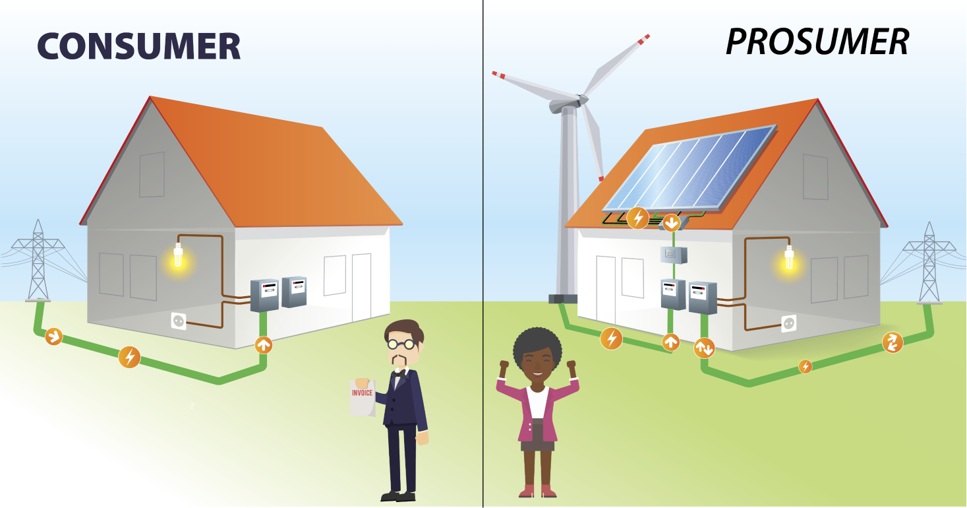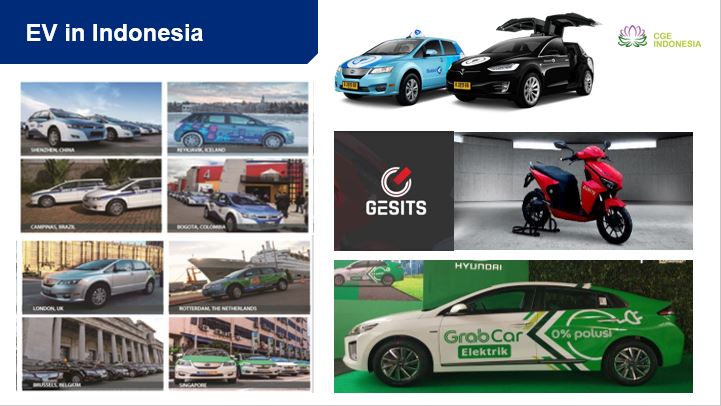Concept of Building Prosumer
The concept of prosumer The word of prosumer is derived from the combination of “producer” and “consumer”. In current conventional energy market, producer and consumer are defined as the different entities at two different ends (top-down architecture), and the energy flows in a single direction. Hence, the energy balancing is performed by the generation side which corresponds to the fluctuation in the demand side. Different to this conventional practice, the concept of the prosumer has the goal to facilitate a mutual platform for the community to exchange both energy and information, as well as interface with the energy entities outside the community. This prosumer movement strongly depends on the transactive energy framework which is able to support bidirectional flows of energy/electricity and information (Knieps, 2016). As the impact of this prosumer movement/change, both price-responsive generation and demand will appear naturally as the response to the fluctuation in the energy conditions and its price. However, both of them are basically influenced
strongly by the inherent characteristics, interests, and attitudes of the individual prosumer toward the economic benefits and comfort. Therefore, the lifestyle, culture and social mindset of the community will also effect the behavior and decision made by each stakeholder.
Figure 1 Concept of prosumer in power market Tushar et al., 2018)
In addition to the basic concept of prosumer, the energy sharing in the community microgrid is also an additional mechanism which can be taken by the community and government. It is clear that the energy sharing among the prosumer stakeholders in the connected community can realize higher economic benefit compared to any independent prosumers without energy sharing among them (Chen et al., 2019). In the case of this energy sharing, the community can have a shared facility controller which controls the energy flow, especially electricity, and also calculate the economic benefits/revenues to all of the participants. In addition, this controller also control the flow of energy/electricity bought from and sold to the grid.
A wider concept of this energy sharing community covers virtual power plant and peer-to-peer trading. Those kinds of concepts tend to increase and are promisingly applicable following the establishment of business model, technological readiness, and government arrangements/policies (Ines et al., 2020). The prosumer schemes basically can be categorized to:
a. Direct-contract and self-arrange
In case that the scale of the prosumer is still relatively small, each player of prosumer can have a direct contract with the utilities/operators. This scheme is also considered applicable for a small-scale microgrid system which has sufficient capability to balance the fluctuation or when a supporting system at the outside of the microgrid is available. By this direct contract, the benefit earned by each prosumer can be maximum. All the fluctuation generated by the prosumer needs to be covered by the existing generation and balancing infrastructures. However, as the number and capacity of prosumer increases, higher fluctuation is generated, resulting in the difficulty to control and uneconomical conditions for the utilities/operators. When the ratio of renewable energy increases and the power fluctuation caused by this increase becomes significant, all the power generated by the prosumer cannot be delivered to the grid. Therefore, the prosumer sides need to arrange by themselves the capacity of the power which can be delivered to or bought from the grid.
a. Direct-contract and self-arrange
In case that the scale of the prosumer is still relatively small, each player of prosumer can have a direct contract with the utilities/operators. This scheme is also considered applicable for a small-scale microgrid system which has sufficient capability to balance the fluctuation or when a supporting system at the outside of the microgrid is available. By this direct contract, the benefit earned by each prosumer can be maximum. All the fluctuation generated by the prosumer needs to be covered by the existing generation and balancing infrastructures. However, as the number and capacity of prosumer increases, higher fluctuation is generated, resulting in the difficulty to control and uneconomical conditions for the utilities/operators. When the ratio of renewable energy increases and the power fluctuation caused by this increase becomes significant, all the power generated by the prosumer cannot be delivered to the grid. Therefore, the prosumer sides need to arrange by themselves the capacity of the power which can be delivered to or bought from the grid.
b. Aggregation
Assuming larger power grid and higher share of renewable energy, aggregation- based mechanism for both production and consumption is believed to be dominant. Through this scheme, each entity of prosumer needs to be registered in certain aggregation service or operator which has the access to the power market. Practically, this scheme can be performed via different mechanisms, including auction (day-ahead bidding), intraday hour-ahead prices, and prices for additional resources which are transacted for the final balancing. In general, similar to the participation in the energy market today, there will be a minimum capacity from the aggregated prosumer which is required for the aggregator/operator to participate in the market. The earned revenue from the service is then divided to the aggregator and prosumer.
Share This Article



